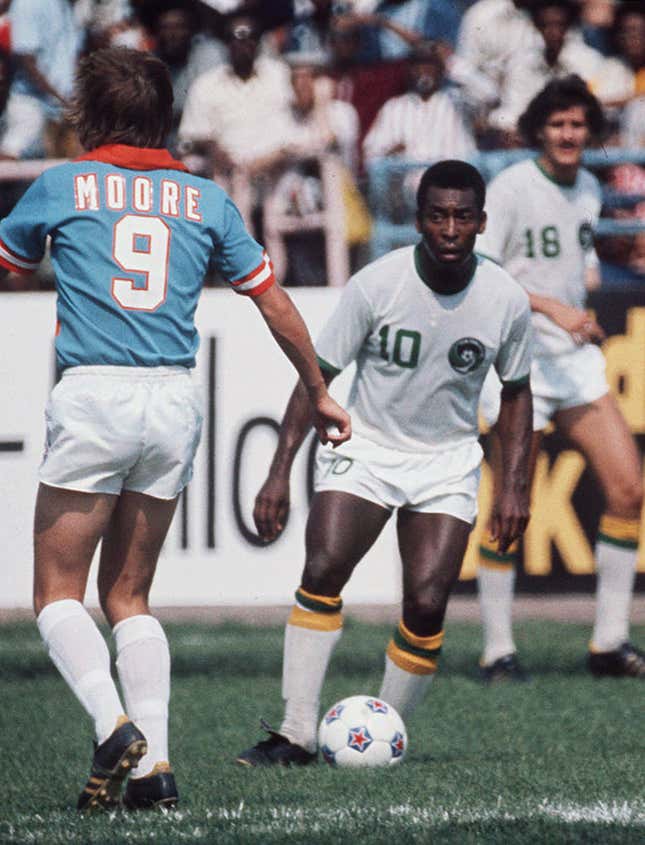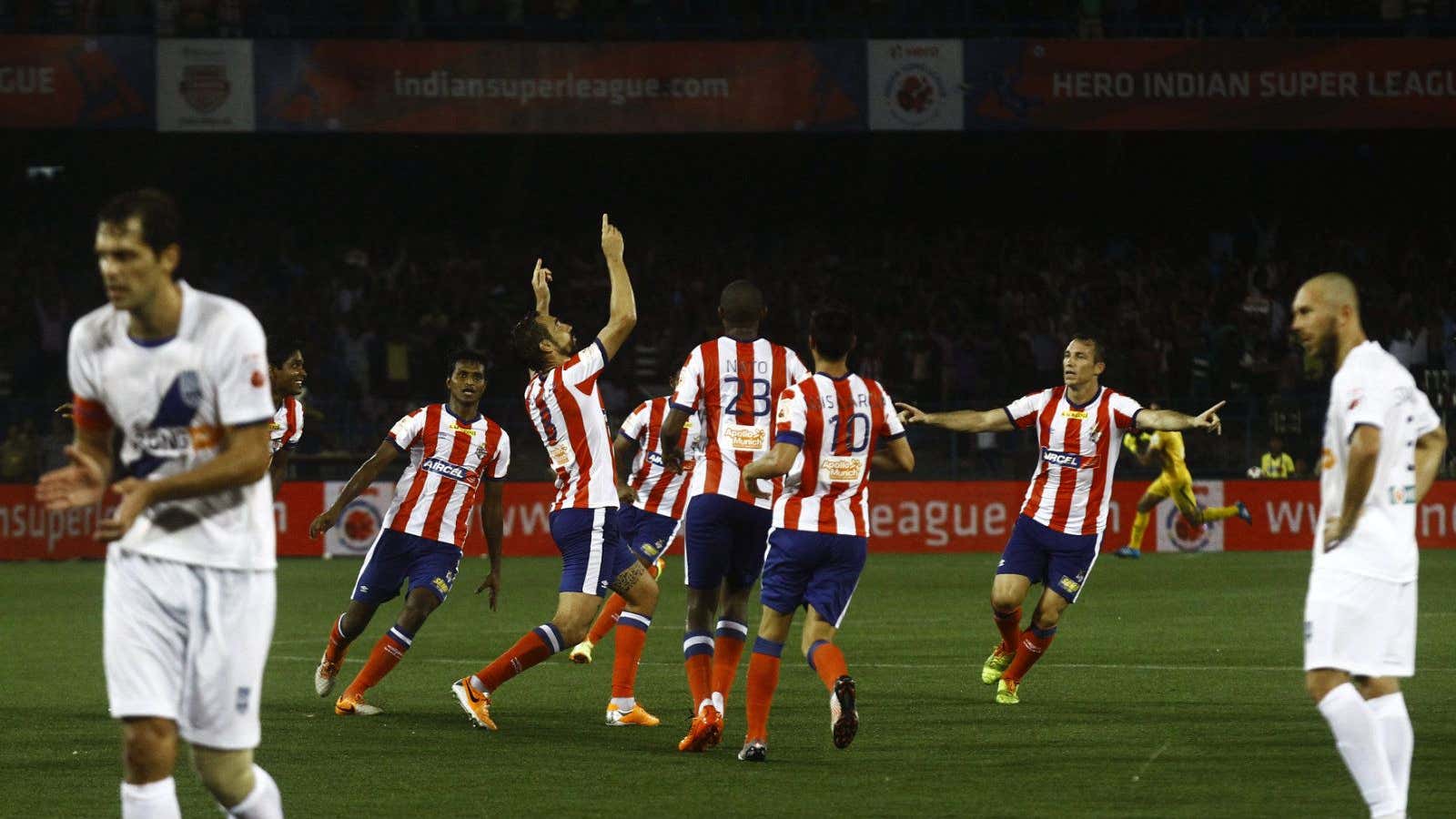After a Bollywood-style opening ceremony that included A-list film stars, dancers, singers and cricketing demigods Sachin Tendulkar and Sourav Ganguly, the eyes of 70,000 fans inside the cavernous Salt Lake Stadium in Kolkata turned to the field. There, marquee player Luis Garcia, a former Barcelona and Liverpool playmaker, was battling it out for the home side Atletico de Kolkata against Mumbai City FC. It looked like football fever.
So has the “sleeping giant“, as FIFA President Sepp Blatter described Indian football in 2007, finally woken up from its long slumber with the launch of the Indian Super League (ISL) yesterday? Will the ISL finally ignite a passion for the beautiful game amongst Indians? Will an Indian Messi grace the fields in the near future?
“This is a baby step for Indian football,” said Paul Masefield, a former defender in the lower English Leagues and now a football analyst. “The ISL has signed big names but the sustainability has to come in four or five years. You can go and watch Freddie Ljungberg, David Trezeguet and Nicolas Anelka and they will have an immediate impact, but there are a lot of questions to be answered in the future. What about the facilities? Who will play in the next seasons? Is it financially viable?”

History suggests that the ISL does need a long-term plan to sustain itself. In the 1970’s and the 80’s, Clive Toye, an English football administrator, believed in the ‘Americanization’ of football and injected the North American Soccer League with foreign star power, bringing Pele, Johan Cruyff and Franz Beckenbauer to America’s shores. Football’s image acquired an aura of exotica, sex and rock and roll—led by the New York Cosmos—but blinded by greed, the NASL expanded rashly and imploded spectacularly. Plenty of franchises were enticed by the glitz and glamour of the Cosmos, but they did not have the financial clout of Cosmos owner and media mogul Steve Ross.
Two years ago, former Chelsea stars Didier Drogba and Nicolas Anelka injected the Chinese Super League with celebrity ethos, but valuing star quality over the natural growth of domestic talent proved to be a mis-hit in China. Drogba was reportedly paid $200,000 by Shanghai, but spending one’s way to victory was not sustainable. The ISL may find itself replicating a model that has failed in the past.
But the league’s marketing train rolls on and has cloned the IPL’s showbiz gene to try and seduce cricket-obsessed Indians. When preaching the gospel of the beautiful game, the ISL claims to be “India’s unrivalled football championship.” A total prize money of Rs15 crores ($2.4 million) and the combined budget of the eight participating franchises make the ISL the most cash-rich venture in the history of Indian football. It is still dwarfed by the money circulating in some of the world’s biggest leagues. The Premier League clubs spent $1.3 billion on transfers alone this summer. The winner of this season’s J-League in Japan will receive more than $2 million in prize money.
In 2010, the All Indian Football Federation (AIFF) signed a 15-year, Rs700 crore ($114 million) deal with Reliance Industries and IMG to form the ISL, which would feature 61 games between October and December. Eight franchises—Chennai, Delhi, Goa, Kerala, Kolkata, Mumbai, Pune and the Northeast—were created, owned by a mix of industrialists, Bollywood stars and former cricketers, who together paid at least Rs12 crore per team.
On the field, Alessandro Del Piero, Robert Pires and other football legends have added flair and panache. The newly recruited foreigners are lured by top dollars and the idea that their fading skills can still win over an entire country.
The IMG-Reliance combine, which bankrolls the league, wants a wide spectrum of fans to embrace the league. The base rate for ISL tickets is Rs200, much lower than the ticket rates for the Indian Premier League, and affordable to even the financially weaker sections of soccer lovers.
For Novy Kapadia, one of India’s leading football experts, the ISL’s success depends on the fans. If football wants to get a toehold, it needs to cultivate a substantial fan base. “Building fan bases takes years,” said Kapadia. “East Bengal and Mohun Bagan have millions of established supporters. They are not going to change overnight to Atletico de Kolkata. The crucial test is will it make Indian players into stars that fans come to watch when the I-League starts in January 2015.”
The I-League—India’s premiere club football competition—is also partially financed by IMG-Reliance, but curiously there is no combined effort to unite and streamline Indian football. The AIFF, charged with the general management of Indian football, is mostly a passive onlooker. Earlier this week, India’s 2-3 defeat at the hands of Palestine was not broadcast live on TV. It was a slap in the face for the AIFF and highlighted its inability in building a competitive team from the grassroots up: India are ranked 157th on the FIFA World Ranking. Tiny, war-torn Palestine is at 102.
North East United and FC Goa have acknowledged a possible symbiosis between the ISL and I-League. They have taken players from the catchment area of I-League clubs Demo and Shillong Lajong FC. The franchises will also benefit by retaining a fan base and player development, but by and large Indian football remains an assemblage of isolated mini-leagues: the ISL now, the I-League in January.
Yesterday, Kolkata dispatched Mumbai with goals from Lemessa, Borja and Arnal, but the football on display was mediocre. The ISL has sold a product—extravaganza over sustainability and quality. Leagues can generate fans, TV-rights, sponsors and other means of income, but without good football and substantial investment in the grassroots, they are bound to falter.
